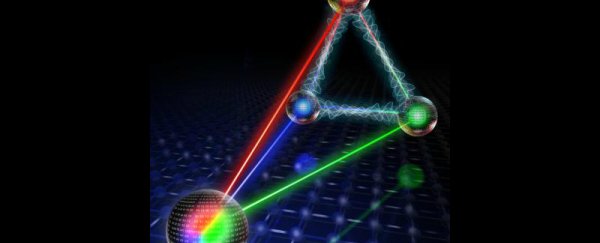An international team, involving researchers from Swinburne University of Technology in Melbourne, Australia, has found evidence that Einstein called "spooky action at a distance" could apply to more than two optical systems.
The discovery, which has been published in Nature Physics, paves the way for the exploration of quantum effects in larger quantum networks than we'd previously considered.
The research centres on the 1935 Einstein-Podolsky-Rosen (EPR) paradox - you know, the one that involved Einstein not believing in quantum entanglement. This is because quantum entanglement states that two particles can be implicitly linked and can seemingly influence each other no matter how far apart they are. Einstein was worried, because this seemed to suggest that information can move faster than the speed of light.
For once, Einstein was wrong, and we now know that quantum entanglement exists, and forms the basis of teleportation and quantum cryptography. Just last year, for example, researchers from the University of Geneva managed to teleport a photon across a distance 25 kilometres.
But, until now, the ability for one system to immediately affect the other, which is known as EPR steering entanglement, had only been investigated between two parties.
"We used an optical network to experimentally confirm how this spooky type of entanglement can be shared over not just two, but three or more distinct optical systems," said Seiji Armstrong, a researchers the Quantum Computing Centre Node at the Australian National University, who was involved in the research, in a press release.
In the experiment, the team used three intense optical beams and showed that they could influence the positions and momenta of each other over a distance.
Importantly, the study was set up with minimal assumption about the nature of the equipment used to measure all but one of the fields.
"The strength of the entanglement created in our network allows us to confirm rigorously – without using any additional assumptions that would create scientific loopholes – the genuine tripartite [three-part] entanglement of three of the optical fields," said Margaret Reid, a Swinburne quantum researcher involved in the study, in the release.
"The experiment therefore provides an important step towards validation of mesoscopic quantum mechanics."
Mesoscopic refers to the discipline of physics that deals with matter in between micro and macroscopic.
This discovery is exciting, because quantum entanglement forms the basis of quantum cryptography - which aims to create "unhackable" passwords that are only accessible if someone has access to an entangled system.
The researchers believe that their methods will now help create more secure systems for iPhones and computers.
Struggling to get your head around all of this? Check out Veritasium's great explanation of quantum entanglement. It'll help, trust us.
Want to create the technology of the future? Find out more about studying at Swinburne University of Technology.
The image at the top of this article was created by Qiongyi He and researchers at Peking and Tianjin University, China, who were also involved in the study.
